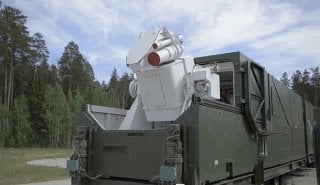Russia Is Developing Laser Weapons to Fight Ukrainian Drones
Russian-based Fly Drones has been deploying an anti-drone laser system—which could be employed to automatically detect, track, identify, and engage the airborne platforms.
Just days into the New Year, a drone attack grounded flights into Russia's second-largest city for more than two hours. According to The Moscow Times, "arrivals and departures at Pulkovo International Airport [outside of St. Petersburg] were suspended" after four drones were spotted in the region. While there were no casualties and the drones did no damage, at least 20 aircraft were redirected to other airports.
The Russian Ministry of Defense also announced via the Telegram social messaging app that it had shot down 16 drones in the Leningrad, Bryansk, Smolensk, Belgorod and Pskov regions.
The Drone Wars
The small unmanned aerial systems (UAS) have been a force multiplier for Kyiv, and it has allowed Ukraine's military to strike targets deep within Russia—in a way that previously might have been possible. As a result, the Kremlin is eager to find ways to counter the threat, and it has turned to a firm that develops digital services for unmanned aerial vehicles (UAVs).
Russian-based Fly Drones has been deploying an anti-drone laser system—which could be employed to automatically detect, track, identify, and engage the airborne platforms.
"Small sizes of modern laser systems make it possible to use them in a stationary or a mobile build. Our company directly took part in trials of one of such systems in late 2024," Nikita Danilov, CEO of Fly Drone, told Russian state media outlet Tass on Thursday.
"Results proved to be successful. We plan to include into our Rubicon anti-drone system already deployed at one of Russian fuel and energy facilities," Danilov added.
Russia's Entry in Laser Weapons
Details are sparse on what Fly Drones' laser platform might encompass, but it is far from the only anti-drone laser-based system Russia has touted. In May 2022, just months after it launched its unprovoked invasion of Ukraine, the Kremlin announced it had begun the deployment of the Peresvet, named after Alexander Peresvet, an Orthodox warrior monk from the Middle Ages.
Last summer, additional details emerged regarding the Peresvet ground-based laser system, which was designed for more than shooting down drones. Rather, the platform is being developed to emit lasers at altitudes of 200 to 1,100 kilometers (125 to 620 miles), over an area of 130 to 180 km (80 to 110 miles), and with a 21 to 155-degree elevation angle. Instead of shooting down aerial targets, it would neutralize enemy reconnaissance satellites.
"The primary mission of Peresvet is to obscure the maneuvering of mobile ground missile complexes, creating uncertainty about their true positions and disrupting enemy reconnaissance efforts. This technology enhances Russia's strategic defense capabilities by ensuring the concealment and protection of critical military movements and installations," The Defence Blog explained in August 2024.
Instead of lasers to counter drones, Russia has sought to employ passive enhancements, including everything from "cope cages" to rubber mats on its tanks and other vehicles, while it relies on traditional air defense systems to shoot down the UAVs.
UK and U.S. Anti-Drone Lasers
The UK's Ministry of Defence seems to have taken the lead in anti-drone laser development, announcing last year that it began testing its DragonFire, a laser-directed energy weapon (LDEW) capable of engaging targets at the speed of light. DragonFire's intense beam of light can reportedly cut through a target—a drone or missile—leading to its structural failure.
The Royal Navy has announced that it plans to deploy the platform by 2027.
The United States Navy has also put a focus on anti-drone LDEWs, but evidently with lower priority, in part because the weapons still have significant shortcomings that will need to be addressed. The biggest issue is that a great deal of energy is required—lasers in the 100kW-range weapons can engage unmanned aircraft, small boats, rockets, artillery, or mortars, while 300kW-range weapons can be employed against the side of a cruise missile fuselage to destroy it or knock it off course.
The laser wouldn't be a blast of energy like those seen in science fiction, and instead could take upwards of 15 seconds of sustained fire to shoot down a drone. As the range is less than a mile, there might be barely enough time to lock on a counter a drone—and nowhere near that time to counter a fast-moving missile.
Future Drone Warriors?
The fact that drones can be difficult and costly to counter, could also explain why Russian President Vladimir Putin has supported efforts to teach Russian schoolchildren how to build and fly drones.
And given that tech entrepreneur Elon Musk is now a close ally of President-elect Donald Trump; the United States could take a similar approach in pushing for a focus on drones as a tool for commerce and war. In November, Musk offered high praise for a Chinese drone presentation while dismissing the Lockheed Martin F-35, suggesting only "idiots" were still focused on manned aircraft.
Author Experience and Expertise: Peter Suciu
Peter Suciu is a Michigan-based writer. He has contributed to more than four dozen magazines, newspapers, and websites with over 3,200 published pieces over a twenty-year career in journalism. He regularly writes about military hardware, firearms history, cybersecurity, politics, and international affairs. Peter is also a Contributing Writer for Forbes and Clearance Jobs. You can follow him on Twitter: @PeterSuciu. You can email the author: [email protected].
Image: Wikimedia Commons.

